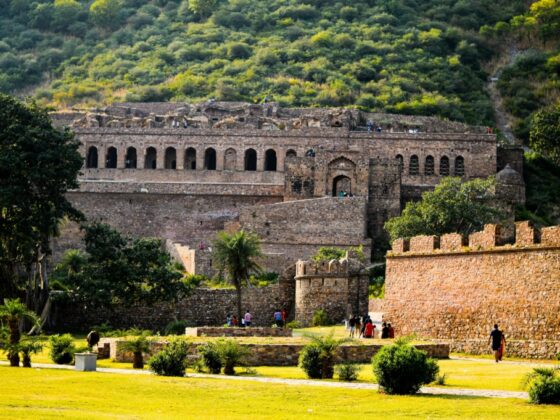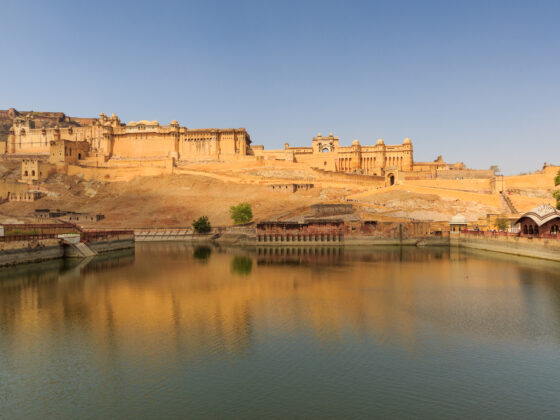Introduction
As the Mughal Empire waned, Central India became a battleground for regional influence. The Holkars of Indore and the Sindhias of Gwalior extended their power into Malwa, placing princely states like Rajgarh under intense pressure. Into this shifting political terrain stepped the British East India Company, poised to reshape loyalties and governance structures. Rajgarh’s rulers embarked on a complex journey of alliances, reforms, and personal transformation to preserve their sovereignty. Rajgarh under the Marathas and the British witnessed dramatic shifts in power, marked by strategic alliances, administrative reforms, and cultural transformation.

Maratha Threat and the Precarious Position of Rajgarh
When Mughal authority weakened in the late 18th century, Maratha armies made inroads into Malwa. Both Sindhias and Holkars demanded revenues and land concessions from Rajput states.
Rajgarh, perched on the Malwa plateau, became vulnerable. Leaders faced frequent tributes, territorial losses, and the threat of military incursion. The state’s finances and internal stability came under serious strain as it struggled to balance Maratha demands with internal governance.
British Engagement: Mediation by Sir John Malcolm
In the early 1800s, Sir John Malcolm negotiated political settlements to limit Maratha influence. For Rajgarh, this meant becoming a protected (mediatized) princely state under British oversight.
As part of the agreement:
-
Rajgarh surrendered land in present-day Shajapur and Guna.
-
In return, the British guaranteed immunity from further Maratha aggression.
-
The arrangement enabled Rajgarh to retain limited sovereignty while British advisors influenced external affairs.
This treaty marked a turning point—granting security from regional rivals at the cost of formal independence.
Sarangpur: Municipal Hub for Rival States
The town of Sarangpur, originally established by the dynasty’s ancestor Sarangsen, became a shared administrative center.
Four states—Rajgarh, Narsinghgarh, Dewas Senior, and Dewas Junior—all claimed jurisdiction at various points.
Eventually, Rajgarh and Narsinghgarh renounced their claims in exchange for regular financial compensation, helping ease administrative complexity while preserving diplomatic relations.
Economic Integration and British Reforms
Under British protection, Rajgarh’s leadership carried out reforms to align with colonial governance:
-
Currency Transition: The state discontinued minting its own coins; British currency became the legal tender.
-
Duties Repeal: Salt and opium taxes were abolished to match British economic policies.
-
Infrastructure Development: Rajgarh supported the construction of the strategic Agra–Bombay Road, enhancing connectivity.
-
War Contributions: During World Wars I and II, the state purchased British war bonds and supported Allied campaigns.
These moves modernized the administration but also deepened Rajgarh’s dependence on the colonial framework.
A Royal Conversion: Moti Singh Becomes Nawab Abdul Wasseh Khan
One of Rajgarh’s most extraordinary stories centers on Rawat Moti Singh. Suffering from a debilitating illness, he sought aid from a visiting faqir from Badakhshan. After healing the king, the faqir declined any reward and instead introduced Islamic teachings.
Impressed, Moti Singh embraced the faith and rechristened himself Nawab Abdul Wasseh Khan. The British formally recognized the change, altering his official designation from Rawat to Nawab.
After his death, when his heirs remained Hindu, the title reverted to Raja—respecting the family’s traditions while honoring a singular episode of faith.
Recognition by the British Crown
The Rajgarh ruler received official honors to cement his allegiance:
-
The title “His Highness”
-
An 11-gun salute, marking ceremonial eminence among princely peers
-
The prestigious KCIE (Knight Commander of the Indian Empire) conferred by Queen Victoria
These distinctions elevated Rajgarh within the hierarchy of British India, enhancing its prestige while reinforcing colonial ties.
Legacy and Transition to Independent India
Rajgarh’s rulers guided their state through a delicate transition. While maintaining loyalty to the British, they also nurtured local institutions and traditions.
By the time of India’s independence in 1947, the ruler voluntarily signed the Instrument of Accession, merging Rajgarh into the Indian Union. Though formal powers ceased, the cultural and social influence of the royal family endured: properties transitioned into public use, family members remained prominent in local affairs, and ancestral customs continued in community life.
Conclusion
The story of Rajgarh during the Maratha and British periods reflects a state navigating turbulent forces through measured diplomacy and strategic concessions. From resisting Maratha dominance to integrating colonial reforms—and a remarkable royal conversion—Rajgarh’s history during this era showcases its leadership’s resilience and adaptability. As the state joined independent India, these episodes became defining chapters in the legacy of the Rajgarh royal family.







